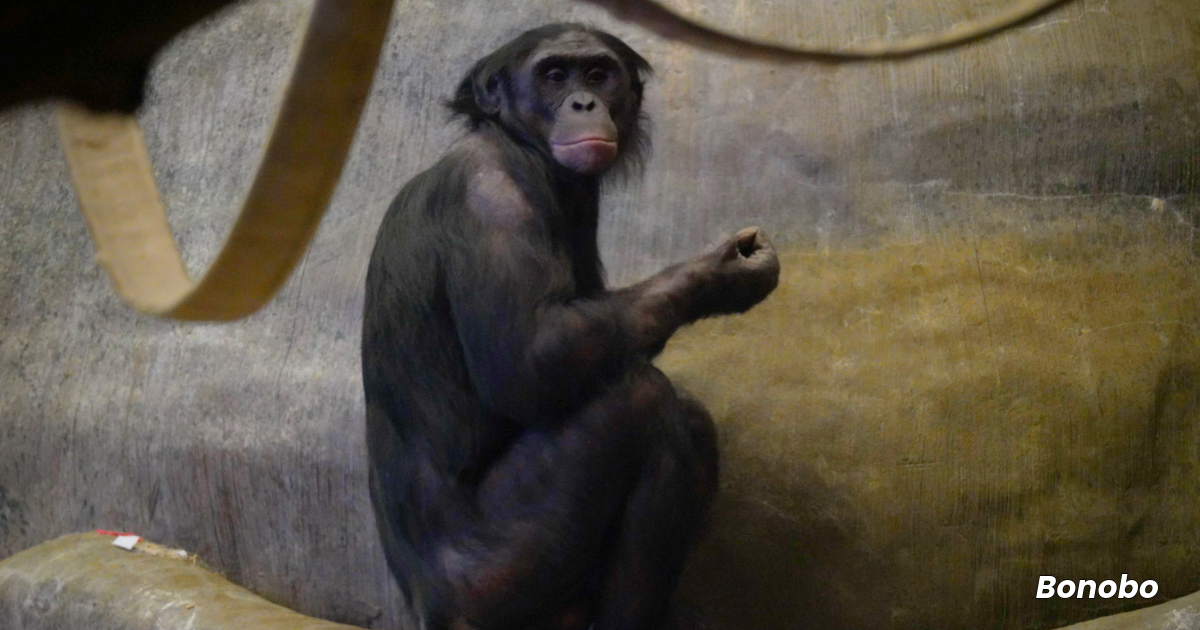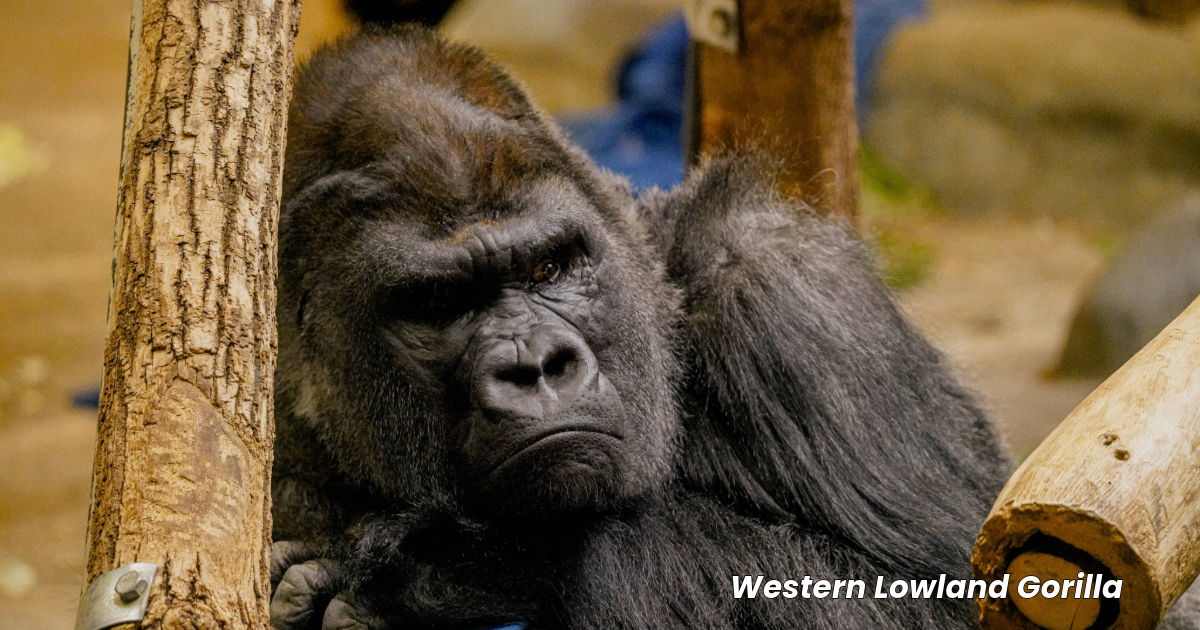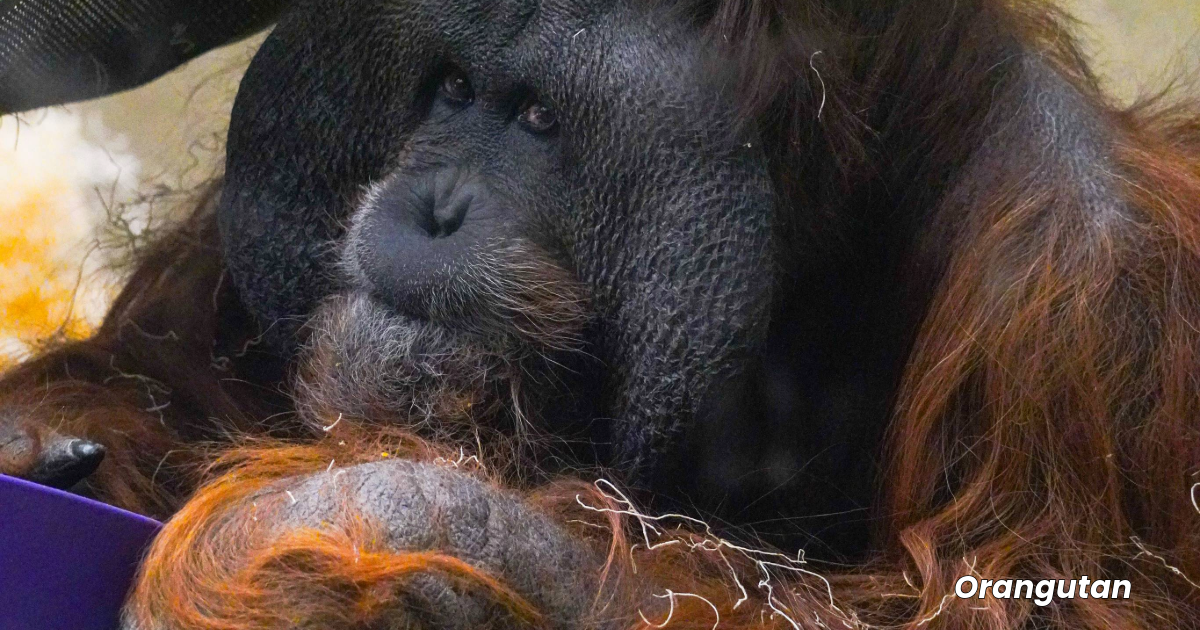The latest installment in the Planet of the Apes film series, Kingdom of the Planet of the Apes, debuted in theaters last month. The movie showed great apes that had evolved to speak and behave in a manner similar to humans. Seeing animals in movies is a great way to inspire us to learn more about them and build empathy for the wildlife around us. But what are they actually like in real life? And which apes can you see when you visit the Milwaukee County Zoo? Here’s what you need to know about the apes in Planet of the Apes:
Bonobos
Character in the movie: Proximus, the ruler of the kingdom
Species at the Zoo? Yes!
While at first glance they may look similar to chimpanzees, bonobos have some key differences from their fellow great apes. Bonobos faces are black, even as infants, and they have small ears that are close to the sides of their head. They can also be a little smaller than chimpanzees, as they tend to weigh between 70 to 100 pounds. Bonobos are excellent climbers and build nests in the forks of trees each night.
Bonobos do share some similarities with chimpanzees besides their appearance. Bonobos tend to eat fruit and leaves, but they also sometimes hunt for fish and small antelope. They are also found in tropical Africa, but only in the rain forest of the Democratic Republic of Congo. It gets plenty hot and wet where they live, as the temperature ranges from 81 to 99 degrees Fahrenheit with rainfall measuring 5 to 6.5 feet annually. And like the chimpanzees, bonobos are also an endangered species according to the International Union for Conservation of Nature (IUCN), with their main threats also being hunting and loss of habitat.
Meet the bonobos at MCZ: The Milwaukee County Zoo is one of only six zoos in the United States with bonobos in their care! There are 18 bonobos at the Zoo — 10 females and eight males. Brian is the oldest member of the community at 35 years old and has a half-brother, Murph, who is the second-oldest at 34 years old. The youngest bonobo is Qasai, who was born in 2016 to his mother, Claudine — the matriarch of the group.
Two of the bonobos at the Zoo, Tamia and Zuri, are both available for sponsorship through our Sponsor an Animal program.
Gorillas
Characters in the movie: Sylva, the military commander of Proximus’ kingdom
Species at the Zoo? Yes!
The largest living primate, there are two species of gorillas — both found in Africa. The Western gorillas are found in the forests of the Republic of Congo, Gabon, Equatorial Guinea and Cameroon, while Eastern gorillas are located in the forests of the Democratic Republic of Congo, Uganda and Rwanda. Adult males weigh between 300 and 500 pounds and stand 4.5 to almost 6 feet tall, while females weigh 150 to 250 pounds and stand between 4 and 5 feet tall. Males also have an impressive reach, as their arm spans stretch from 7.5 to 8.5 feet!
Like chimpanzees and bonobos, gorillas are social animals that live in troops consisting of two to 30 individuals. They also mainly eat fruit, leaves, termites, ants and larvae. Both species of gorilla are listed as critically endangered by the IUCN, as they also are threatened by poaching and habitat loss.
Meet the gorillas at MCZ: After the arrival of Azizi earlier this year, there are now five Western lowland gorillas at the Zoo. Azizi, who turns 21 in December, is part of the family troop with Dotty, 20, and Nadami, 13. The Zoo’s bachelor troop consists of Maji Maji, 32, and Hodari, 29. The gorillas rotate between the indoor and outdoor habitats, with Azizi, Dotty and Nadami interacting in the same habitat together, while Maji Maji and Hodari each prefer to have the habitat to themselves when they are viewable to the public.
Azizi and Nadami are both available for sponsorship through our Sponsor an Animal program.
Orangutans
Character in the movie: Raka, a scholar and follower of the teachings of Caesar
Species at the Zoo? Yes!
Unlike the other great apes, orangutans are found halfway around the world in the islands of southeast Asia. Two of the three species of orangutans, the Tapanuli and the Sumatran, are found on the island of Sumatra, while the Bornean orangutan lives on the island of Borneo.
Fact Check: Like some male orangutans, in the movie Raka did not have large cheek pads. However, the majority of males across all three species have large cheek pads that give it a distinctive flat, round looking face.
Unlike the other great apes, orangutans prefer to spend most of their time up in the trees, and they also tend to almost exclusively eat fruit. But like the gorillas, orangutans are also listed as critically endangered by the IUCN due to habitat loss and poaching.
Meet the orangutans at MCZ: The two orangutans that call the Zoo home, Tommy and Alex, are both hybrid orangutans — meaning they’re each half-Sumatran, half-Bornean orangutans. Tommy is one of the oldest residents of the Zoo, as he was born here on March 18, 1982. Tommy likes to stay in the indoor habitat, where he can eat healthy snacks like yogurt and fruit juice while making elaborate forts to watch people from. Alex was born almost exactly one year later at the Henry Vilas Zoo in Madison, and she arrived at the Milwaukee County Zoo in 2019. Alex likes to hang out in the outdoor habitat and eat foods like oranges, coconuts, lettuce and carrots. She also enjoys decorating her room by hanging up bed sheets and then resting underneath tubs or other large objects. You may also see her sometimes put her fingers in her ears. That means people are being a bit too noisy for her liking, so you should try lowering your voices if you see her doing this behavior!
Tommy and Alex are both available for sponsorship through our Sponsor an Animal program.
Chimpanzees
Character in the movie: Noa, the main protagonist trying to find his kidnapped village
Species at the Zoo? No
Native to the forests and savannahs in tropical Africa, chimpanzees live in groups that range in size from a dozen or so members to over 100. Measuring 4 to 5 feet tall, male chimpanzees can weigh between 80 to 150 pounds, while females can weigh 60 to 110 pounds. According to the IUCN Red List, chimpanzees are an endangered species, as they face habitat loss due to mining and farming and are also targeted by poachers.
Many chimpanzees have been observed using tools to help gather food like honey, termites, nuts and water. Chimpanzees, typically the males, will sometimes hunt for food as well, and when they return with the food, they have been observed dividing the food among the hunters and non-hunters in their community.
Did you know? Chimpanzees, along with bonobos, are the only two species in the genus Pan. The two species are also the closest living relatives to humans!



